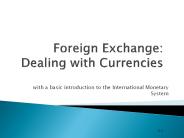A Structural Break in the Effects of Foreign Exchange Intervention on YenDollar Exchange Rate Volati - PowerPoint PPT Presentation
1 / 22
Title:
A Structural Break in the Effects of Foreign Exchange Intervention on YenDollar Exchange Rate Volati
Description:
The empirical literature: Is (Japanese) foreign exchange intervention effective? ... Change Point Detector for ARCH models (Kokoszka/Leipus 1999) identifies: ... – PowerPoint PPT presentation
Number of Views:34
Avg rating:3.0/5.0
Title: A Structural Break in the Effects of Foreign Exchange Intervention on YenDollar Exchange Rate Volati
1
A Structural Break in the Effects of
Foreign Exchange Intervention on Yen/Dollar
Exchange Rate VolatilityEric Hillebrand,
Louisiana State University Gunther Schnabl,
European Central Bank and Tübingen University
March 2005
2
Outline
- Setting the stage Yen/Dollar and Interventions
- The measure of success
- The empirical literature Is (Japanese) foreign
exchange intervention effective? - Data and reaction function for the Bank of Japan
- Global GARCH, Local GARCH
- Interpretation of the findings
- Conclusion
3
1. The Syndrome of the Ever-Higher Yen
??
observation period
4
Japanese Foreign Exchange Intervention
5
US Foreign Exchange Intervention
foreign reserves in Dec. 2004 Japan 820 billion
dollars (20 GDP) US 43 billion dollars (0.5
GDP)
6
2. The Measure of Success
- Returns cause Intervention, Intervention causes
returns? - Endogeneity bias!
- Two strands of literature 1) Intervention as a
problem of optimal control (Mundaca/Oksendal
1998, Cadenillas/Zapatero 2000) - 2) Intervention as empirical problem GARCH plus
intervention as exogenous variable - Successful intervention Reduces volatility. No
statements possible about direction of exchange
rate movement. - Is there an endogeneity problem with volatility?
7
Exchange Rate Level and Intervention
8
3. The empirical literature
- Observation consensus" among central bankers
- Sterilized interventions are ineffective.
- Foreign exchange intervention increases
volatility because of higher uncertainty. - Only interest rate changes (unsterilized
interventions) trigger adjustments of
international capital flows and thereby exchange
rate changes. - sterilized intervention is effective
- portfolio-balance models (Branson 1983)
- signalling effects (Mussa 1981)
- international coordination (with US) (Bryant 1995)
9
3. The empirical literature
- Japanese foreign exchange intervention is not
effective - Schwartz 1996 exercise in futility causing
higher volatility - Bonser-Neal/Tanner 1996 higher volatility
(85-91) - Dominguez 1998 higher volatility (77-94)
- Galati and Melick 1999 higher uncertainty
(93-96) - Japanese foreign exchange intervention is
effective - Ramaswamy/Samiei 2000 at least partially
effective (90-98) - Ito 2002 effective since 1995 (91-01)
- Beine/Szafarz 2003 effective when coordinated
with US (91-01) - Fatum/Hutchison 2003 successful (91-00)
- Nagayasu 2004 effective when coordinated with US
(91-01)
10
4. Data
- actual intervention data (day, volume, currency)
- Japanese Ministry of Finance (MOF)
- Federal Reserve Board
- observation period April 1991 Oct. 2004
(updated) - daily exchange rate data provided by Bloomberg
Datastream - Tokyo 5 p.m.
- New York noon (London 5 p.m., Tokyo 2 a.m. t1)
- New York 5 p.m. (Tokyo 7 a.m. t1)
- number of observations
- 3542 trading days
- 344 intervention days (9.71) (US 22 / 1.01)
11
Bank of Japan Reaction Function
- Possible determinants of intervention
- percentage exchange rate changes of the previous
day rt-1 - deviation of exchange rate from a target value
- exchange rate volatility (rt-1)2
- intervention of the previous day
- binary probit model (ID0 or ID 1)
12
Results for the Reaction Function
- Japanese foreign exchange intervention is
triggered by the exchange rate but not exchange
rate volatility. - The exchange rate term in the mean estimation can
be subject to endogeneity bias.
13
5. Global GARCH Estimation 1991-2004
14
Local GARCH Estimation
- All previous estimations (Ramaswamy/Samiei 2000,
Ito 2002, Beine/Szafarz 2003, Fatum/Hutchison
2003, Nagayasu 2004) were global. - Global approaches assume that the effects of
Japanese foreign exchange intervention are
unchanged during the whole observation period. - Structural breakswhich may distort the
resultsare ignored. - To identify structural breaks we re-estimate the
model - year by year (arbitrary),
- intervention clusters (arbitrary),
- periods built by change point detection (non-
arbitrary).
15
Yearly Results 1991-2004
- Intervention reduces exchange rate volatility
starting in 1999. - Before volatility seems to increase.
16
Results for Intervention Clusters
17
Change Point Detector
- Change Point Detector for ARCH models
(Kokoszka/Leipus 1999) identifies - periods with different volatility
- non-arbitrary segmentation
- specification
- Detected change points
- 7. May 1997
- 3. April 2000
18
Results for Change Point Detection
- Structural break after 1999?
19
Rolling GARCH(1,1) Coefficients
- Window size 500, 750, 1000, 1250, 1500
20
Rolling GARCH(1,1) Coefficients
- Window size 500, 750, 1000, 1250, 1500
structural break around 1999/2000
21
6. Interpretation of the Findings
- Empirical Plausibility
- In line with recent financial press reports.
- Horst Köhler (August 2003) Tokyos
unprecedented foreign exchange intervention is
pragmatic and helps stabilizing the financial
system. - In line with reduced low-frequency yen/dollar
exchange rate volatility (McKinnon/Schnabl
2004a). - Theoretical Plausibility
- If Japanese foreign exchange intervention remains
sterilized the finding is surprising. - If in the liquidity trap foreign exchange
intervention is regarded as unsterilized, the
finding is in line with the conventional wisdom
on the efficacy of foreign exchange intervention.
22
7. Conclusion
- Marked change in the influence of Japanese
interventions on the volatility around 1999/2000. - Possible reasons changed intervention
credibility, liquidity trap - Challenges
- Endogeneity problem Success in influencing the
direction of FX movements?































